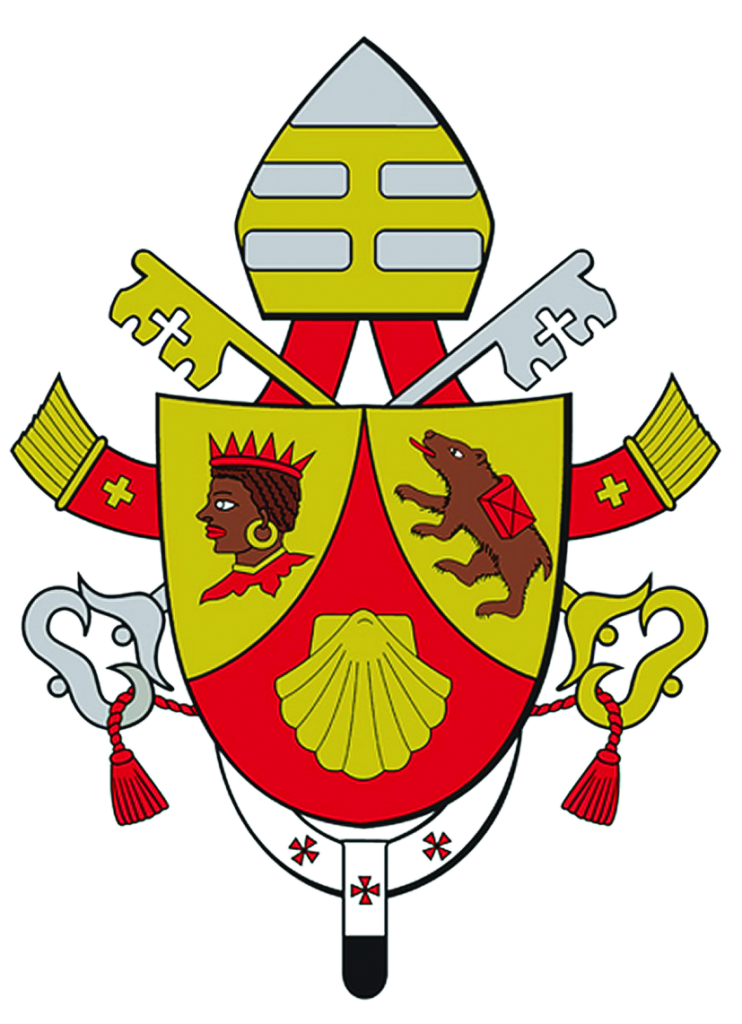The Papal Conclave of 2005 elects the “humble laborer in the vineyard of the Lord”

Coat of arms of Benedict XVI. The scallop shell is an allusion to the Sacrament of Holy Baptism and is also a symbol of pilgrimage. The red-crowned head of a Moor represents Pope Benedict’s origins and is also a reference to the Order of St. Benedict. The bear carrying a red pack represents Pope Benedict’s trust in God and his calling to spread the faith to others
After only two days of voting, the 117 cardinal electors chose a successor to the charismatic and beloved John Paul II: the shy German professor who only wished to retire and write books.
The 2005 papal conclave was convened to elect a new Pope following the death of Pope John Paul II on April 2, 2005. Of the 117 eligible members of the College of Cardinals, those younger than 80 years of age at the time of the death of Pope John Paul II, all but two attended.
All the electors were appointed by Pope John Paul II except for three: Filipino Jaime Sin, who was not attending, American William Baum and the German Joseph Ratzinger, making Baum and Ratzinger the only participants with previous conclave experience from the two conclaves of 1978.
It ended the following day after four ballots with the election of Cardinal Joseph Ratzinger, Dean of the College of Cardinals and Prefect of the Congregation for the Doctrine of the Faith. After accepting his election, he took the pontifical name of Benedict XVI.
Ratzinger, who in early April 2005 was identified as one of the “100 most influential people in the world” by Time, had repeatedly stated he would like to retire to his house in the Bavarian village of Pentling near Regensburg and dedicate himself to writing books.
At the papal conclave, “it was, if not Ratzinger, who? And as they came to know him, the question became, why not Ratzinger?” said Austin Ivereigh, English Catholic writer and then-spokesman for English Cardinal Cormac Murphy-O’Connor. On April 19, 2005, Ratzinger was elected on the second day after four ballots.
Cardinal Murphy-O’Connor described the final vote: “It’s very solemn when you go up one by one to put your vote in the urn and you’re looking up at Michelangelo’s Last Judgment. And I still remember vividly the then-Cardinal Ratzinger sitting on the edge of his chair.” Ratzinger had hoped to retire peacefully and said that “At a certain point, I prayed to God, ‘Please don’t do this to me’… Evidently, this time He didn’t listen to me.”
At the balcony, Benedict’s first words to the crowd, given in Italian before he gave the traditional Urbi et Orbi blessing in Latin, were:
“Dear brothers and sisters, after the great Pope John Paul II, the Cardinals have elected me, a simple, humble laborer in the vineyard of the Lord. The fact that the Lord knows how to work and to act even with insufficient instruments comforts me, and above all I entrust myself to your prayers. In the joy of the Risen Lord, confident of his unfailing help, let us move forward. The Lord will help us, and Mary, His Most Holy Mother, will be at our side. Thank you.”
On April 24, Benedict celebrated the Papal Inauguration Mass in St. Peter’s Square, during which he was invested with the Pallium and the Ring of the Fisherman.
The Pope explained his choice of name during his first general audience in St. Peter’s Square, on April 27, 2005:
“Filled with sentiments of awe and thanksgiving, I wish to speak of why I chose the name Benedict.
“Firstly, I remember Pope Benedict XV, that courageous prophet of peace, who guided the Church through turbulent times of war. In his footsteps, I place my ministry in the service of reconciliation and harmony between peoples.
“Additionally, I recall St. Benedict of Nursia, co-patron of Europe, whose life evokes the Christian roots of Europe. I ask him to help us all to hold firm to the centrality of Christ in our Christian life: May Christ always take first place in our thoughts and actions!”






Facebook Comments